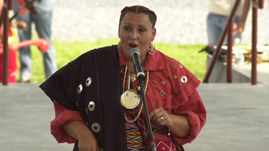Teachers' Domain - Digital Media for the Classroom and Professional Development
User: Preview



Cherokee singer Paula Nelson performs a learning song that teaches a greeting and farewell in Cherokee and then asks the audience to sing with her in a call and response conversation. In the second part of the segment, Nelson says that the Cherokee people are a “water people” and performs a song called “It’s Going to Rain.” Her performance was taped at the 2006 Festival of Native Peoples in Cherokee, N.C.
This resource is part of the Native American Culture collection.
Find additional arts resources for your classroom at the KET Arts Toolkit website.
“Si-yo.” That’s Cherokee for “hello.” Songwriter Paula Nelson is a member of the Eastern Band of Cherokee who lives in the Big Cove Community of Cherokee, N.C. She teaches Cherokee words through song, helping to keep her language alive. In one song, she uses call and response to teach the greeting “Si-yo” and a farewell. Instead of “goodbye,” however, the Cherokee say “’til we meet again” or “De-da-da-go-hv-ya.”
The Cherokee are one of many Native peoples living in the Americas. Long before European explorers arrived on America’s shores, Native peoples lived, hunted, and developed rich cultures throughout North and South America. Music and dance have been an integral part of Native American life from earliest times, used then and now as part of rituals and ceremonies; to tell stories, teach lessons, and pass along history; and for entertainment.
Singers like Paula Nelson sing solo or in groups, use a variety of forms, and perform with and without accompaniment. There is immense variety in the songs, rhythms, meters, vocal styles, and purposes. There’s variety in the instruments as well, but you can pretty much count on hearing drums and other percussive instruments such as rattles, clappers, and scrapers. The flute is also popular.
This song uses the form call and response, in which one singer sings a musical statement and other singers respond with a musical statement.
 Loading Standards
Loading Standards